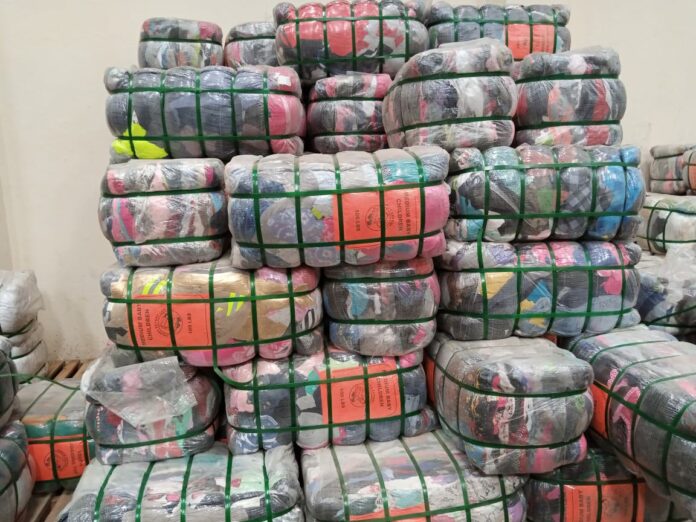Being the family’s third generation owner of a family business Nehruji Baiji has been running the business for close to 10 years selling clothes and executive bags.
Baiji says that business was doing good in the ’80s and ’90s when clients spent their money on new clothes and accessories. The increased expenditures kept local businesses thriving and pumped life into the cotton textile and apparel industry.
Currently, the shop sales have dropped by 40 per cent due to high running costs and cheaper imports by from stall traders and second-hand (mitumba) clothes.
In the past, shop sales could reach Sh700,000 per month but currently, Baiji says he makes almost Sh450,000 per month and the profit isn’t much to celebrate since if you take Sh100,000 rent, salaries, restocking and other utilities the profit is marginal.
William Mogaka has been selling second-hand clothes (mitumba) in Nairobi’s CBD without paying any expenses. His only expense is Sh3000 which he uses to purchase his daily stock in the Gikomba market.
Catherine has been running a Mitumba depot near City Stadium in Nairobi for a decade making an average profit of Sh200,000 monthly.
She deals in bales of assorted women’s clothing that cost between Sh20,000 and Sh25,000, while a bale of ladies’ handbags costs anywhere from Sh14,000 to Sh18,000. Men’s outfits, on the other hand, are the priciest, with bales fetching as much as Sh40,000.
“This business has been my backbone, helping me support my family and cover expenses like my children’s education.” Said Catherine.
Public policy expert Anthony Mwangi, a former CEO of the Kenya Association of Manufacturers, points out an interesting fact that Kenya is a major supplier for top fashion brands in the US like H&M, Levi’s, JC Penney, Wrangler and Otto.
“Although our apparel exports bring in around Sh51 billion and have gained global recognition, the country is still heavily reliant on imports. This calls for a fresh push to revive the local textile industry,” Mwangi said.
Industry History
Dating back to the 80s and 90s Kenya’s textile industry was thriving, covering everything from strong fibre to finished fashion. The sector had a strong supply chain that supported both local and international markets through efficient production processes.
At its prime in 1984, the country had around 52 textile mills and employed half a million garment workers.
According to government data, currently, only four textile mills remain and employ about 54,000 workers. The decline started in the late ’90s when cotton farmers abandoned the crop due to low prices.
Once a thriving cash crop and a lifeline for thousands of families, cotton farming collapsed, cutting off the local supply of raw materials and leaving the industry struggling to stay afloat.
Industry PS Juma Mukhwana recalls a time when Kenya was thriving in cotton, textiles, and apparel, playing a major role in foreign exchange earnings.
“But the sector took a hit with trade liberalization and import of second-hand clothes,” he remarks in the National Cotton Textile and Apparel Policy paper.
The industry struggles due to the uncontrolled flow of cheap mitumba imported from overseas, which weakens local manufacturer
Along with challenges such as expensive production, poor infrastructure, limited funding options, and lack of strong policies to uplift the industry which has led to the closure of factories, workers losing jobs and a decline in local cotton production.
Eldoret-based Rivatex has also taken a downturn despite the government pumping over Sh7 billion into modernizing the state-owned mill. The factory now provides jobs for more than 1,200 people, with another 10,000 benefiting indirectly through the cotton industry, thanks to donor support.
“A dependable supply of raw materials is essential. Rivatex requires 200,000 acres of land dedicated to cotton cultivation to eliminate shortages,” management said.
Number of Kenyans given Canada visitor visas falls 72pc in one year
The company needs over 7.2 million kilos of cotton per year but receives less than half of that supply.
Employment and Revenue
The textile industry, once a major employer, has seen job numbers decline from 500,000 in the 1990s to just 20,000.
Outside the textile mills, the wider value chain still offers some opportunities, but challenges like outdated machinery, high production costs and stiff competition from cheap imports have crippled local manufacturing.
Principal Secretary Mukhwana points out that while Kenya’s apparel industry is vibrant, it struggles with quality, branding, and market reach.
Exports to the US under the African Growth and Opportunity Act (AGOA) bring in revenue, but locally, the sector is barely surviving as Mitumba dominates.
Despite concerns about its impact on local production, the Mitumba sector is a key economic player, contributing at least Sh1 billion monthly and supporting nearly two million livelihoods.
Jobs in this sector range from importation and distribution to tailoring and reselling. The Mitumba Consortium Association of Kenya (MCAK) argues that second-hand clothing serves a huge demand, especially among low and middle-income earners.
MCAK chairperson Teresia Wairimu suggests that instead of trying to phase out mitumba, Kenya should build a textile industry that works alongside it
Government Intervention
The government is counting on the National Cotton Textile and Apparel Policy to pump life into the struggling local textile industry.
In addition, it’s also pushing for homegrown fabrics through the ‘Buy Kenya, Build Kenya’ campaign, urging consumers to choose local over imported alternatives.
According to the State Department for Industry, this policy is designed to tackle the deep-rooted problems that have weakened Kenya’s cotton, textile, and apparel sectors.








